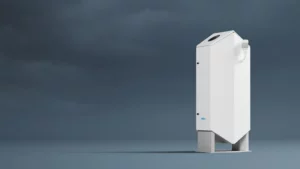
Vaisala Lidar Ceilometer CL61
Get to know the first-of-its-kind sensor combining standard ceilometer measurements with advanced depolarization and particle differentiation.
Like no other ceilometer
The Vaisala CL61 ceilometer is a first-of-its kind technology that combines standard ceilometer measurements, like cloud base and ceiling heights, with new depolarization capabilities. Depolarization allows for precise particle and precipitation type differentiation, enabling dramatically improved situational awareness and forecasting. CL61 is also easy to integrate, cost-effective, and backed by Vaisala’s globally trusted sensor technology and service capabilities. All this makes CL61 unique among ceilometers — an outstanding, cost-effective tool for improving decision-making and safety across several key applications.
Data-rich vertical profiles
See more than ever before — when it matters most. CL61 uses attenuated backscatter profiles measured in 2 polarization directions to calculate the depolarization ratio. The depolarization measurement not only enables the liquid/solid differentiation, but also makes it possible to detect dust, sand and volcanic ash. Improved optical system allows high signal to noise ratio and enables reporting of detailed vertical profiles for the full range, up to 15.4 km (9.6 mi).
Trusted technology
With Vaisala, our technology is proven and backed by decades of experience in ceilometer development. With the CL61 single-lens technology, traceable calibration, depolarization, and ultrapure profiles, you receive accurate, research-grade data and professional support to improve your forecasting.
Cost-effective
Even with its new depolarization measurement, the CL61 lidar ceilometer comes in at a fraction of a cost compared to other research lidars. Its low price point allows for the option to deploy multiple instruments in order to improve measurement coverage.
Low maintenance
The CL61 sensor is simple to set up, and operates autonomously any time, without the need for calibration. Rely on uninterrupted depolarization profiling and data around the clock, and in all weather conditions.






